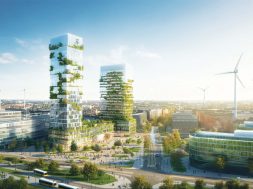Living in green
Going green is the new buzzword, and there are several examples where the existing buildings are retrofit with sustainable features.
Green building uses environmentally responsible and resource-efficient process throughout a building’s life cycle. Although new technologies are constantly being developed to complement current practices in creating greener structures, the common objective is to reduce the overall impact of the built environment on human health and the natural environment.
In order to achieve that, a green building efficiently uses energy, water and other resources. A green building also reduces waste, pollution and environmental degradation. Even a green building costs less to operate and have excellent energy performance.
Goals of green buildingsThe main objective of a green building is environmental, economic and social benefits. “Green building or green construction aims to reduce the environmental impact of building on its surroundings throughout its life cycle from sitting to design, construction, operation, maintenance, renovation and demolition,” explains Pankaj Kaushal, VP – Architecture, REPL. “The common objective is that green buildings are designed to reduce the overall impact of the built environment on humans and the environment by efficient use of energy, water and other resources, protecting occupant health, improving employee productivity, and reducing waste, pollution and environmental degradation.”Green building brings together an array of practices, techniques and skills to reduce and ultimately eliminate the impacts of buildings on the environment. It often emphasises on renewable resources like using sunlight through passive solar, using plants and trees through green roofs and reducing rainwater run-off.
However, modern sustainability initiatives call for an integrated and synergistic design to both new construction and in the retrofitting of existing structures. Also known as sustainable design, this approach integrates the building life cycle with each green practice employed with a design-purpose to create a synergy among the practices used.
Green means saving energyThe importance of how buildings are designed, built and managed is recognised as being able to influence the negative impact of the built environment. Contributing up to 40 percent of CO2 emissions and 40 per cent of energy consumption, buildings have a major impact on climate change.
Green buildings include measures to reduce energy consumption – both the embodied energy required to extract, process, transport and install building materials and operating energy to provide services such as heating and power for equipment.
“A green home uses less energy, produces less waste and uses eco-friendly materials in its construction,” opines Mr Kaushal.
He adds, “One of the most important tasks is to reduce greenhouse gas emissions. An increasing concentration level in the atmosphere is said to be the main reason for rising temperatures. For instance, the CO2 concentration in most industrialised countries has increased by more than 20 per cent in the last 60 years.”
Perfect design for green buildingsMost important step towards constructing a green building usually occurs during the design process. Design of a green building needs to be done from the point of view of optimal life-cycle costs, not the first cost. Many aspects of a building’s performance depend on design stage interventions. Appropriate passive architecture techniques, sun path analysis, and orientation and climatic responsive envelope design are measures which can contribute to a great extent if applied at the right stage.
However, there is nothing as perfect design for a sustainable structure. It is contextual. One must understand the end-use application of the building and appropriate design needs to be worked out. Design stage is the very crucial to build in sustainability in the project.
According to M. Selvarasu, Director, LEAD Consultancy & Engineering Services (India) Pvt. Ltd., “The aim to adopt strategies for best practices and achieve target green goals based on the requirement. This can be achieved through focusing on minute details such as proper selection of site, building orientation and form, glass properties, material selection, heating, cooling, ventilation, daylighting, waste management, recycling, irrigation management, renewable energy solution and water conservation through efficient plumbing fixtures.”
Challenges to develop green buildingsAchieving sustainability in building poses several challenges. There are two reasons for the slow adoption of sustainability in India: technical and financial. Organisations like IGBC are working to turn around these impediments. With Green Building Rating System, IGBC is helping buildings sustain energy-efficient practices over the life of a building.
Sustainability and energy efficiency are the 21st century buzzword. India only needs to educate the people about the benefits of green buildings. Once the technology and materials are locally available and pricing become competitive, green buildings will be widely accepted.
Essential products for green buildingsFor a green building, materials matter — inside and out. Take Bayer MaterialScience for example. “Our building materials and technologies make products easier for architects to meet their green building goals without sacrificing design aesthetics,” says Ajay Durrani, Managing Director, Bayer MaterialScience. “Bayer presents a list of technologies from energy-efficient insulation to durable, aesthetically pleasing polycarbonate window glazing, pultruded polyurethane window lineal, advanced coatings and sealants and materials for light emitting diodes (LEDs).”
Building materials which consume less energy are used in green buildings. “Green buildings use non-damaging and less dangerous materials, carpets, paints and sealants when possible,” explains Mr Kaushal. “This ends in better indoor air, thus reducing one’s odds of respiration sicknesses and irritations and could also decrease the risk of cancer and help environmentally delicate folks live and breathe less complicated.”
He further adds, “Building materials typically considered to be ‘green’ include lumber from forests that have been certified to a third-party forest standard, rapidly renewable plant materials like bamboo and straw, dimension stone, recycled stone, recycled metal and other products that are non-toxic, reusable, renewable and recyclable. These blocks have low density and are lightweight. Use of recycled industrial goods, such as coal combustion products, foundry sand and demolition debris, is also suggested in construction projects.”
Trends and opportunitiesThe green buildings concept has caught up and gained great impetus over the years. Sustainable buildings take into account the building’s entire life cycle. Mr Kaushal endorses this thought too. He explains, “Green buildings are gaining momentum and could account for 20 per cent of all constructions by 2030. They are healthier places to live and work, reduce energy and water use, and generate better profits.”
Mr Durrani also feels the same. “Green building in India will continue its strong growth in the near future. There is a growing focus on energy efficiency in all kinds of buildings, especially on the increasing role of building automation. Other trends that will continue to develop include the use of solar power in buildings, the focus on materials, waste and recycling as well as onsite water treatment solutions.”
“The current trends in green building are to optimise cost and maximise operational savings to the company by adopting cost-effective solutions,” explains Mr Selvarasu. “We drive message very strongly to our clients that ‘green makes economic sense’ through design optimisation without compromising operational benefit to building owners and improved health for occupants.”
_____________________________Green building or green construction aims to reduce the environmental impact of building on its surroundings throughout its life cycle …
Pankaj Kaushal, VP – Architecture, REPL_________________________
The current trends in green building are to optimise cost and maximise operational savings to the company by adopting cost-effective solutions.
M. Selvarasu, Director, LEAD Consultancy & Engineering Services (India) Pvt. Ltd.________________________________There is a growing focus on energy efficiency in all kinds of buildings, especially on the increasing role of building automation.
Ajay Durrani, Managing Director, Bayer MaterialScience
Cookie Consent
We use cookies to personalize your experience. By continuing to visit this website you agree to our Terms & Conditions, Privacy Policy and Cookie Policy.









